The Desktop Kabini Review Part 1: AMD Athlon 5350 (AM1) Tested
by Ian Cutress on April 9, 2014 8:00 AM ESTCPU Benchmarks
Console Emulation – Dolphin Benchmark: link
At the start of 2014 I was emailed with a link to a new emulation benchmark based on the Dolphin Emulator. The issue with emulators tends to be two-fold: game licensing and raw CPU power required for the emulation. As a result, many emulators are often bound by single thread CPU performance, and general reports tended to suggest that Haswell provided a significant post to emulator performance. This benchmark runs a Wii program that raytraces a complex 3D scene inside the Dolphin Wii emulator. Performance on this benchmark is a good proxy of the speed of Dolphin CPU emulation, which is an intensive single core task using most aspects of a CPU. Results are given in minutes, where the Wii itself scores 17.53; meaning that anything above this is faster than an actual Wii for processing Wii code, albeit emulated.
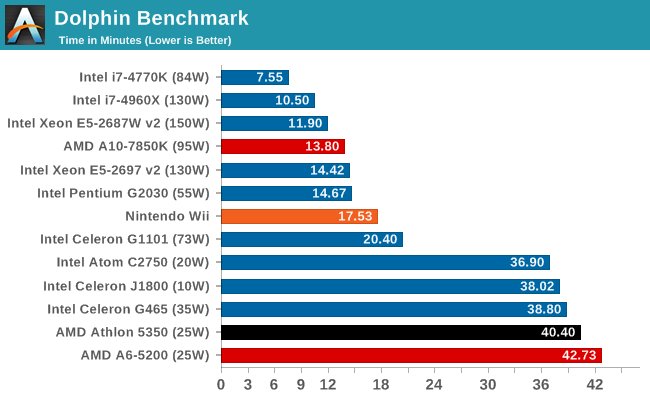
Point Calculations – 3D Movement Algorithm Test: link
3DPM is a self-penned benchmark, taking basic 3D movement algorithms used in Brownian Motion simulations and testing them for speed. High floating point performance, MHz and IPC wins in the single thread version, whereas the multithread version has to handle the threads and loves more cores.
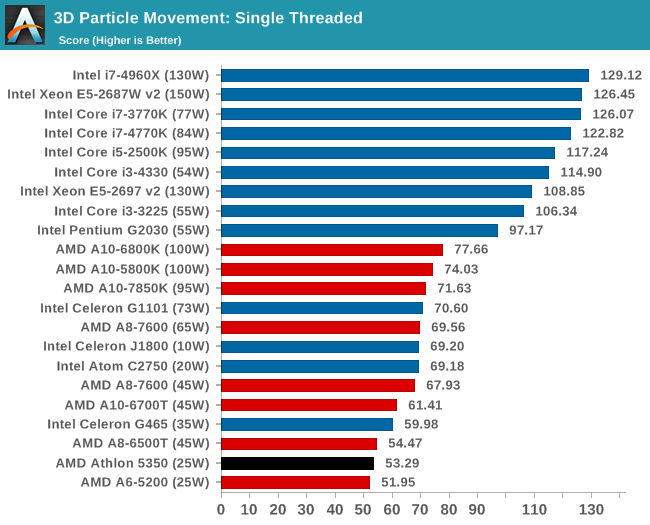
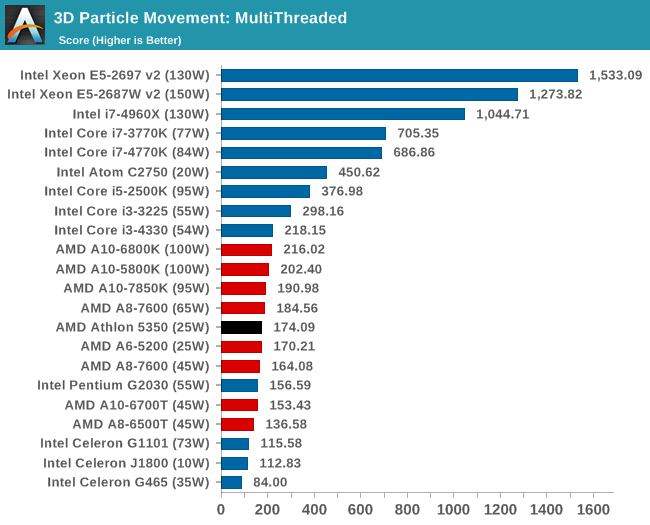
Encryption –TrueCrypt v0.7.1a: link
TrueCrypt is an off the shelf open source encryption tool for files and folders. For our test we run the benchmark mode using a 1GB buffer and take the mean result from AES encryption.
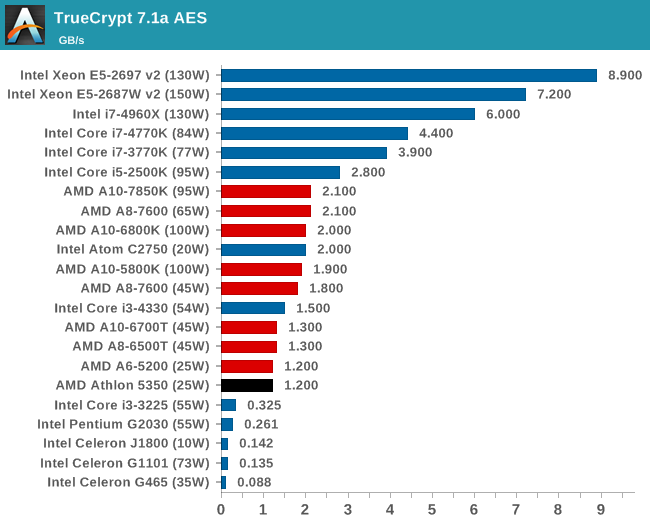
Synthetic – 7-Zip 9.2: link
As an open source compression tool, 7-Zip is a popular tool for making sets of files easier to handle and transfer. The software offers up its own benchmark, to which we report the result.
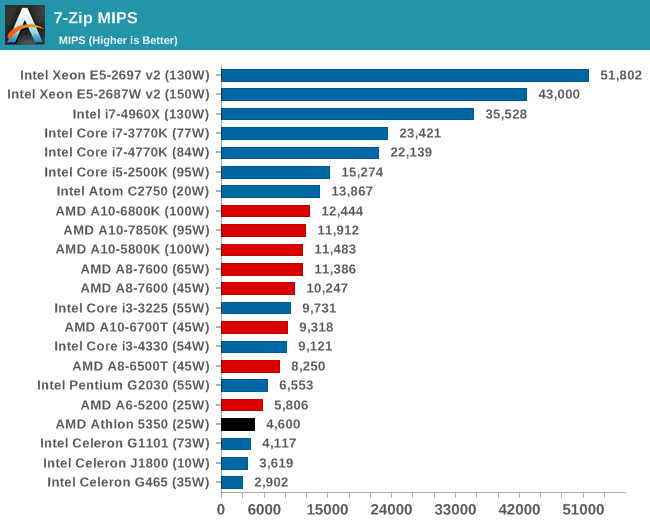
Rendering – PovRay 3.7: link
The Persistence of Vision RayTracer, or PovRay, is a freeware package for as the name suggests, ray tracing. It is a pure renderer, rather than modeling software, but the latest beta version contains a handy benchmark for stressing all processing threads on a platform. We have been using this test in motherboard reviews to test memory stability at various CPU speeds to good effect – if it passes the test, the IMC in the CPU is stable for a given CPU speed. As a CPU test, it runs for approximately 2-3 minutes on high end platforms.
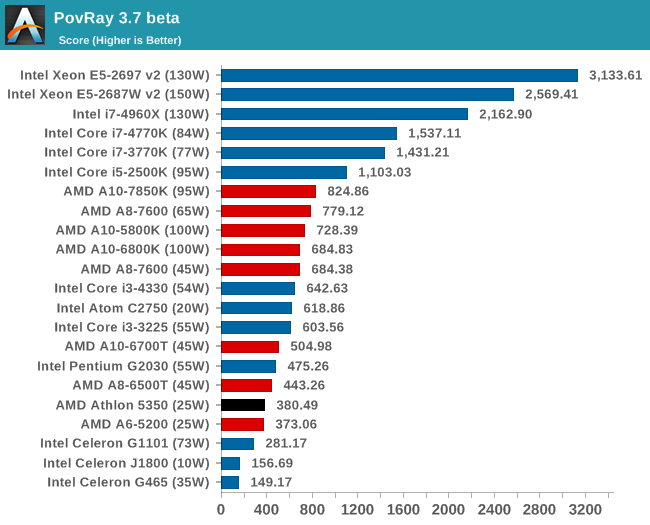










126 Comments
View All Comments
kyuu - Wednesday, April 9, 2014 - link
Yeah I was going to say something about that. The article text and the graphs are not in agreement.kallogan - Wednesday, April 9, 2014 - link
ground breaking new tech ! Wow !Alexey291 - Thursday, April 10, 2014 - link
wowsuch tech
much ground breaking
wow
evonitzer - Wednesday, April 9, 2014 - link
In addition to what you are already planning to test, I would like to see some of the low end A4 or A6 APU's tested. They seem to be a blank spot for your reviews, making it tough to compare the cheap stuff against the previous generation. The A4's come with the same 2 CU GPU, but presumably better cpu performance, and are available pretty close to $50. Sure, they are higher TDP, but whatev.Anyway, interesting review. I'd be seriously tempted if I didn't just put together a cheap PC for my brother already. Maybe grandma can get a surprise upgrade ...
evonitzer - Wednesday, April 9, 2014 - link
Oh hold on, there aren't any A4's or A6's available in Kaveri form, which means no GCN to be had for cheap. That's interesting. I wonder how much difference it makes on the low end. Well either way, the A4-6300 (and below) are still interesting to compare.Glory2God - Wednesday, April 9, 2014 - link
That Atom C2750 looks awesome in the multi threaded benchmarks.rogueninja - Wednesday, April 9, 2014 - link
AMD dualcore, quadcore, octacore, 100 cores. Who give a damn. They're as fast as a turtle.Nintendo Maniac 64 - Wednesday, April 9, 2014 - link
Would have been nice if there were more older CPUs to compare to, like Athlon 64 x2, first gen Phenom X4, and Conroe Core 2 Duo (rather than Wolfdale). It'd be even better if said older CPUs were around 2.0-2.5GHz as wellsaiki4116 - Wednesday, April 9, 2014 - link
Please add comparison with A4-4000(40 USD) and A4-6300,they could cost 10-20usd more than kabini.BushLin - Wednesday, April 9, 2014 - link
Anandtech, where's the power consumption figures? Just quoting the 25w TDP feeds assumptions such as the one I'm replying to.Why is it every time AMD have a CPU worth buying (doesn't happen that often) you guys manage to totally miss the point in the review? It's enough to make an objective person sound like a fanboy.
I'll save you the trouble:
http://www.tomshardware.com/reviews/athlon-5350-am...
Although making the typical reviewer mistake of using a very high wattage PSU on a low power system, we can at least see something close to parity between an Athlon 5350 and a Celeron J1900 (the very same CPUs you reviewed).
Makes quite a different outcome doesn't it?